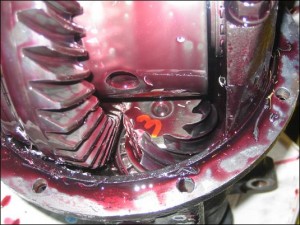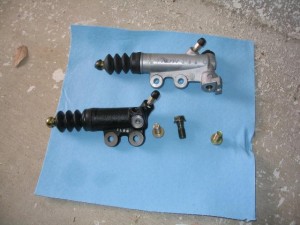Demystifying the AP2 Drivetrain
Once or twice a year, since the AP2 came to market, I hear some S2000 owner or another talk about the issue of clutch slip and the clutch delay valve (CDV) in the AP2 S2000. As well, over the years, I continue to hear the same incorrect “facts” spouted off by those owners about the CDV, as a sort of incorrect folklore passed on in the oral tradition, similar to “angry gods cast lightning from the heavens”. (If you actually believe that stuff, we’ll need to have a separate conversation…)
It’s easy to see why this occurs, as not many people understand the CDV, or an automotive clutch system in general, very well, and to make sense of them, tend to tie the easy-to-spot visible elements together rather than look for the deeper relationships, as this requires a more thorough understanding of how it all works. That is, in fact, how the legend of the CDV was born – someone felt a difference in how the AP2 drove compared to an AP1, looked under the car, and saw a different part, which they concluded must be the reason for the behavior. Just like our ancestors thought gods threw lightning, it was a simple way to explain something not understood at the time. Today, eight years after the introduction of the AP2, I’m writing in attempt to outline the science behind the folklore and share the actual facts we know so you too can be informed and knowledgeable about the CDV, AP2 “slip”, and maybe even lightning.
Briefly, in 2004 when Honda released the revised S2000 chassis, designated “AP2”, there were a Honda-claimed 2,000 changes made to the car. Two of these are the revised clutch slave cylinder and the revised drivetrain flywheel. AP1 S2000s at the time had a reputation for two big dependability issues; glass differentials, as they broke on hard launches, and mechanical overrevs from money shifts that would blow an engine. Both of these dependability issues were actually caused by driver error or abuse, but they occurred often enough that Honda saw fit to improve the system.
Two direct “fixes” were put in place, in addition to a number of other improvements beyond the scope of this article. To address overrevs, a heavier flywheel was put into the car to give a bigger cushion between rising rpm and blown engines. To address broken differentials, a clutch delay valve was used to prevent driveline shock. Both had a noticeable effect on the driving characteristics of the S2000, but not everyone, Honda included possibly, understood how each worked and how they affected the car’s character.
Let’s start with the CDV. On a hard launch where the clutch is “dropped” (typically evidenced by spinning wheels, smoky burnouts, etc), the S2000’s differential is the weakest link in the drivetrain system between the engine and the tires. As opposed to a smooth start where one gently applies throttle and engages the clutch system to power the wheels, when the clutch is dropped, the power of the engine, previously disconnected from the wheels, “shocks” the system with massive energy, which we hope manifests as wheels spinning suddenly and causing a show as you go. What we don’t want to manifest is the wheels not moving and all that excess power blowing the diff into tiny metallic pieces. Simply put, when S2000 drivers don’t provide enough gas to break traction on launch, the diff is what breaks instead, and a CDV helps prevent this by limiting the energy delivery to a substantial but not overwhelming rate.
So what does the CDV do exactly? In short, it regulates the flow of clutch fluid in one direction through the slave cylinder, so you can disengage the
clutch quickly but it will always re-engage at an engineered pace – quick enough not to be noticed or cause significant clutch slip, slow enough to prevent shock damage to parts of the drivetrain like the differential.
The effect the CDV has on everyday driving is minimal but noticeable, and can be described as putting a piece of velvet between a hammer and nail. It softens the feel of the blow while still allowing enough power to get the job done. If you drive S2000s back to back with and without a CDV, this “veil” is what you’ll feel in the clutch take-up, although many people incorrectly relate the feeling of the flywheel to the CDV as well, so let’s take a look at that now.
The flywheel, simply put, is where the engine and the drivetrain hook up, via the clutch system. It has one of the largest effects on engine responsiveness because it is directly connected to the engine even when the rest of the drivetrain is not. As a mass, the heavier it is, the more energy it stores and the more effort it takes to change its inertia. A light flywheel “fills” with energy quickly, so engine rpm can quickly race up or down. A heavy flywheel holds more energy and holds it longer, which also causes rpm to rise and drop more slowly.
Additionally, flywheels spin, so their weight is also subject to centripetal acceleration, which magnifies the effect of their mass. Sitting on a table, an AP1 flywheel weighs 14 pounds and an AP2, 22 pounds – roughly 35% heavier. That weight is magnified when they start spinning at engine rpm as high as 8,300, and the difference is noticeable in the rate with which engine rpm rise and fall between the two models of the S2000.
In the S, more slowly rising rpm meant less chance of blowing your engine on a money shift because you have that little extra bit of time to correct your mistake before it all goes up in smoke. Although improved engine internals also play a part, history shows that AP2 overrevs result in far fewer blown engines than they do in AP1s, so it’s safe to say the heavier flywheel successfully did its part in saving engines.
The down side to the AP2’s heavier flywheel, however, is that the rest of the clutch system was not upgraded to handle its increased mass, and thus its increased energy capability, for quick shifts. Specifically, the pressure plate, the part of the clutch system that pushes the clutch friction disc against the flywheel to connect the drivetrain and transfer all the engine’s energy to the wheels, was not beefed up to handle the higher energy capability of the bigger flywheel, so the excess energy the flywheel now holds translates into slip at high rpm. The OEM flywheel simply doesn’t have the force necessary to stop the moving parts quickly and effectively, and this translates into S2000 owners complaining of slip at redline shifts, but not at lower rpm shifts.
The best way to manifest this is to try an experiment in your AP2. Take the car to 4,000 rpm in first or second gear, and power-shift the car. You will feel no slip as the clutch (even with CDV in) bites and the car pulls away (if you do, you probably have a weak or bad clutch). This happens because the energy stored in the 22 pound flywheel does not yet exceed what the pressure plate can handle. Now try the same thing at 8,000 rpm, and notice not just a slip, but a long, floaty, slip that can last several seconds. You can try this experiment at different rpm and you will experience different amounts of float, but it gets worse as rpm rise and as more excess energy is fed into the flywheel. Do not do too much of this as it puts excess wear on your friction disc!
So, what is happening here? Normally, when you engage the clutch, the pressure plate pushes the friction disc against the flywheel disc, friction happens, the two quickly start spinning at the same rate, and the power goes to the wheels. With the AP2 however, the clutch friction disc ends up sliding along the flywheel as the pressure plate pushes down without the force necessary to cause friction lock. The slip continues until the pressure plate can drag the clutch up to a speed and/or the flywheel down to a speed at which the two discs can bite and synch up. The excess energy is lost as slip, heat, and premature clutch wear if you shift too quickly. This is also the easy way to know that the CDV is not the culprit here as this happens even without the CDV in place.
So, what to do? There are several options available to the AP2 owner, assuming one even thinks the CDV and 22 pound flywheel are problems. The biggest problem is one of perception, as when the AP2 debuted, people still tried to drive it like the old AP1, and you have to drive the two cars a bit differently as they aren’t exactly the same.
Because of the differences in the drivetrain and clutch system, stock for stock, you have to shift an AP2 more slowly than an AP1 to properly drive the car, but the heavier flywheel in an AP2 means you actually can shift slower without penalty since the energy is not lost as quickly as it is with an AP1 flywheel. This allows you to shift more smoothly, thus not upsetting the car as much between shifts. To some, this is not actually a problem at all, but a characteristic difference between AP1s and AP2s. If you are aware of it, and pay attention, you won’t be frustrated by the different behavior of the two cars when shifting.
However, if you want an AP2 to have a more characteristic AP1 feel in its shifting behavior, there are several avenues available to you. Primarily, they are to change the flywheel, change the pressure plate, remove the CDV, or any combination of the three.
As noted earlier, removing the CDV will give you a more direct feel, but not much else. Still, feel is a subjective thing, and you may prefer the metallic crunch of an unadulterated clutch system. You can either remove the CDV from an AP2 slave cylinder, or replace an AP2 slave with an AP1 unit, as it is a direct bolt-on replacement. In the latter case, if you don’t like the feeling you can always revert to the original part.
As for fast shifting and driveline slip, you can replace the AP2 flywheel with a stock AP1 unit to give an AP2 the shifting characteristic of an AP1 and eliminate flywheel slippage. A lighter flywheel will also be noticeable to an AP2 owner when revving the engine, as the lighter flywheel maintains less inertia and the engine will seem peppier in its revs than before.
The third option is to upgrade the stock AP2 pressure plate to a unit that can manage the heavier AP2 flywheel. In its stock form, the OEM pressure plate applies 1300 pounds of force. A popular aftermarket choice, the ACT pressure plate provides double the gripping power at 2600 pounds, enough to keep the extra energy of the 22 pound flywheel in check. Simply installing this plate solves slippage issues when fast-shifting the car, although it can be combined with the lighter flywheel to greatly change the shifting character of an AP2.
Over the years, many S2000 owners have tried different combinations of these solutions, using different brands of parts in the process. For an AP2 owner, the difference can be as simple as changing one’s behavior to match the car’s nature, or changing the car’s nature to suit the driver. In any case, you at least know more about the science behind the S2000.
And by the way, lightning is the discharge of an electrical field in the sky.
Photos courtesy BO(RED), negcamber, and billman250.



